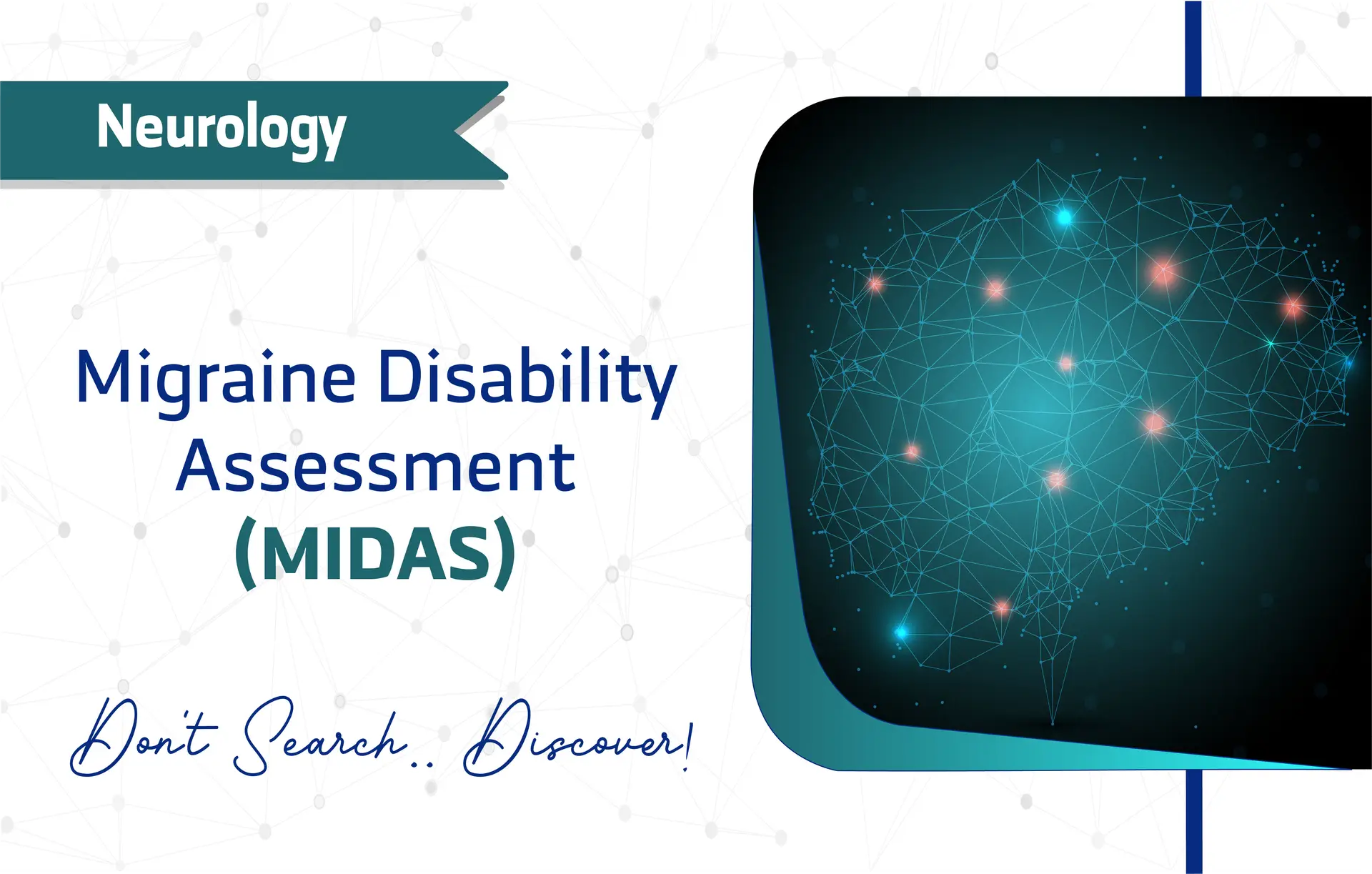Introduction
Migraine, a debilitating neurological condition, affects millions globally, significantly impacting quality of life. To address this, the Migraine Disability Assessment (MIDAS) questionnaire, developed by Richard B. Lipton, Walter F. Stewart, and colleagues in 2001, offers a validated tool to quantify migraine-related disability over a three-month period. By assessing functional impairments in work, household chores, and social activities, MIDAS enhances physician-patient communication and informs clinical decisions.
Consequently, it has become a cornerstone in both clinical practice and research, endorsed by the International Headache Society for its reliability and applicability. This article explores the key features, applications, and limitations of MIDAS, tailored for researchers and clinicians seeking to improve patient outcomes.
Key Features of the Migraine Disability Assessment (MIDAS)
Purpose and Use of the Migraine Disability Assessment
The MIDAS questionnaire is designed to measure migraine-related disability by quantifying the impact on daily activities over a three-month period. Specifically, it evaluates missed or reduced productivity in work/school, household chores, and family/social events. By providing a standardized measure, MIDAS facilitates better communication between physicians and patients, guiding clinical decisions for treatment prioritization.
Target Population
MIDAS is validated for adults aged 18 and older, including:
- young adults (18–24).
- middle-aged adults (25–44).
- older adults (45–64).
- seniors (65+).
It is specifically designed for patients with episodic or chronic migraines, ensuring broad applicability across diverse migraine populations.
Structure of the Migraine Disability Assessment (MIDAS)
MIDAS consists of five scored questions and two unscored questions (A and B) that assess headache frequency and pain intensity. The scored questions Assess days with ≥50% reduced productivity or missed activities due to migraine across:
- Paid work or education
- Household chores
- Family/social events
- Reduced productivity at work/school
- Reduced productivity in household tasks.
Each question requires numerical input regarding the number of days affected, making the questionnaire straightforward and quick to complete, typically in less than five minutes.
Scoring Method
MIDAS employs a simple and direct scoring method where the total score is derived from the sum of days reported across the five scored questions. This total score then categorizes migraine-related disability into four distinct grades:
- Grade I (0–5): Minimal disability
- Grade II (6–10): Mild disability
- Grade III (11–20): Moderate disability
- Grade IV (≥21): Severe disability
These categorical grades are instrumental for clinicians, helping them prioritize treatment strategies for patients with higher disability levels and effectively monitor changes in disability over time. Additionally, the two additional unscored questions (A and B) collect informationon the frequency of headaches and the intensity of the headachepain. These are not scored in the MIDAS Questionnaire but areincluded to provide the physician with clinically relevant informationthat may aid in treatment and management decisions.
Additional notes
The MIDAS score is derived as the sum of lost days due to headache recorded for Questions 1 to 5. It can sometimes be higher than the actual number of lost headache days if more than one domain of activity is affected on the same day. Under these circumstances, the score reflects the range of demands in an individual’s life whether or not an individual works for pay. Although individuals who do not work for pay answer only three questions, the two relevant domains are likely to be more important than they are for those who do not work for pay. In previous work, the HImQ score for individuals who worked for pay did not differ from those who did not work for pay.
Administration Format of the Migraine Disability Assessment
The MIDAS offers flexibility in administration and can be completed via:
- Paper-based forms.
- Digital (Online) platforms.
- Interviews (In-person).
- Phone/Video Call.
No special training is necessary to administer or interpret the MIDAS, as it is self-administered and easily managed by healthcare staff. Administration is typically quick, estimated at less than 5 minutes.
Applications of the Migraine Disability Assessment (MIDAS)
MIDAS serves multiple purposes in clinical and research settings:
- Screening: Identifies patients with significant migraine-related disability.
- Monitoring: Tracks changes in disability over time, especially in response to treatments.
- Treatment Planning: Guides clinicians in prioritizing interventions for high-disability patients.
- Research: Widely used in clinical trials to evaluate treatment efficacy and disability outcomes.
For example, MIDAS is recommended by the US Headache Consortium for disability assessment in treatment guidelines, underscoring its clinical relevance.
Languages and Availability
To support global use, MIDAS is available in over 20 languages, including:
- Arabic
- English
- Spanish
- French
- German
- Russian
As well as Hindi, Japanese, Mandarin Chinese, and Portuguese. This multilingual accessibility ensures MIDAS can be used in diverse clinical and research settings worldwide.
Reliability and Validity
MIDAS is highly reliable and valid, with a test-retest reliability of r = 0.83 and strong criterion validity compared to clinical judgment (Lipton et al., 2001). Validation studies, such as those published in Neurology such as (Stewart et al., 2000), confirm its effectiveness across episodic and chronic migraine populations. With over 1,200 citations on Google Scholar, MIDAS is endorsed by the International Headache Society for clinical and research use.
Cost and Licensing of the MIDAS Questionnaire
MIDAS is freely available for non-commercial use, requiring no permission or licensing fees. Developed through academic collaboration; no specific commercial publisher. Originally published by the American Academy of Neurology (ANN) in the journal Neurology, it is now widely disseminated and not proprietary, making it accessible for academic and clinical applications.
Other Versions
MIDAS has adaptations to suit specific populations:
- PedMIDAS: A pediatric version for pediatric and adolescent.
- 1-Month Recall MIDAS: Used in clinical trials to reduce recall bias, particularly for chronic migraine patients.
These versions enhance MIDAS’s flexibility for diverse research and clinical needs.
Related Questionnaires
Researchers and clinicians may find it useful to be aware of other questionnaires that are similar or complementary to the MIDAS, such as:
- HIT-6 (Headache Impact Test).
- WHODAS 2.0 (World Health Organization Disability Assessment Schedule).
- MSQ (Migraine-Specific Quality of Life Questionnaire).
Limitations and Considerations
However, despite its strengths, the MIDAS has a few limitations:
- Self-report: Respondents may be influenced by social desirability bias or personal interpretation.
- Recall Bias: The three-month recall period may lead to inaccurate reporting, especially for chronic migraine patients.
- Overlapping Domains: Scores may overestimate disability if multiple domains are affected on the same day.
Additional Resources
For further exploration, consider these resources:
- Original Validation Study, Study link.
- MIDAS Questionnaire PDF.
- For inquiries, contact via headache research institutions such as the American Headache Society or the International Headache Society.
Additional MIDAS resources are available through Neurology.
Frequently Asked Questions (FAQ)
- Who can use the MIDAS?
Clinicians, researchers, and healthcare providers use MIDAS for adults aged 18 and older with migraines. - How long does it take to complete the MIDAS?
Patients typically complete MIDAS in under five minutes, making it efficient for clinical and research settings. - How is the MIDAS administered?
MIDAS can be administered via paper, digital formats, phone, or in-person interviews, offering flexibility in usage. - Is there any cost to using the MIDAS?
MIDAS is free for non-commercial use. For commercial or funded academic projects, contact the American Headache Society for permissions.
A word from ResRef about the Migraine Disability Assessment (MIDAS)
The MIDAS questionnaire is a cornerstone tool for quantifying migraine’s real-world impact, enabling clinicians to prioritize care for high-disability patients. Its brevity, ease of use, and cross-cultural adaptability make it indispensable in both clinical practice and research. While limitations like self-report bias exist, its role in guiding evidence-based treatment decisions remains unparalleled.
References
- Stewart WF, Lipton RB, Dowson AJ, Sawyer J. Development and testing of the Migraine Disability Assessment (MIDAS) Questionnaire to assess headache-related disability. Neurology. 2001;56(6 Suppl 1):S20-8. doi: 10.1212/wnl.56.suppl_1.s20. PMID: 11294956. Study link.
- Stewart WF, Lipton RB, Kolodner KB, Sawyer J, Lee C, Liberman JN. Validity of the Migraine Disability Assessment (MIDAS) score in comparison to a diary-based measure in a population sample of migraine sufferers. Pain. 2000 Oct;88(1):41-52. doi: 10.1016/S0304-3959(00)00305-5. PMID: 11098098. Study link.
- Lipton RB, Stewart WF, Sawyer J, Edmeads JG. Clinical utility of an instrument assessing migraine disability: the Migraine Disability Assessment (MIDAS) questionnaire. Headache. 2001 Oct;41(9):854-61. PMID: 11703471. Study link.









1 thought on “Migraine Disability Assessment (MIDAS): A Full Guide for Researchers and Clinicians”
That is very attention-grabbing, You are a very skilled blogger.
I have joined your rss feed and stay up for searching for
more of your fantastic post. Additionally, I have shared your site in my
social networks